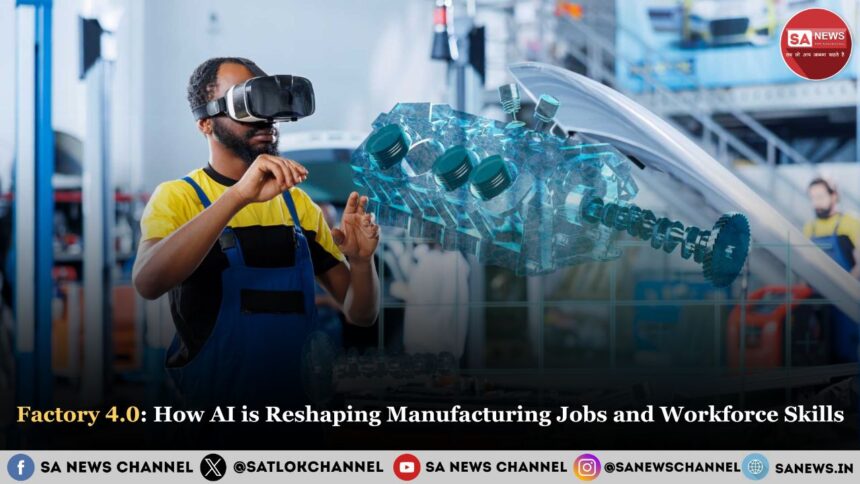Manufacturing, once defined by blue-collar labor and mechanical repetition, is now undergoing its biggest transformation yet. Dubbed Factory 4.0, this AI-driven revolution is blending intelligent robotics, Internet of Things (IoT), predictive analytics, and real-time data to create self-optimizing, self-correcting, and hyper-efficient production systems.
- How AI Is Changing Manufacturing Jobs
- 1. Replacing Repetitive Labor
- 2. Creating High-Tech Roles
- 3. Declining Demand for Low-Skilled Workers
- 4. Rise of Human-Machine Collaboration
- Skills of the Future: What Workers Must Learn Now
- Global Implications – Winners, Losers, and the Inequality Gap
- Adapting Without Losing Ourselves
- FAQs on AI in Manufacturing
Factory 4.0, also known as the Fourth Industrial Revolution, goes beyond traditional automation. It integrates:
- AI & Machine Learning: For real-time decision making
- Industrial IoT: Sensors and devices that communicate across machines
- Digital Twins: Virtual replicas of manufacturing systems
- Autonomous Robots: Self-navigating machines on the floor
- Cloud & Edge Computing: Instant data access and analysis
These systems are capable of adjusting production schedules autonomously, detecting machine faults before they occur, and even predicting demand surges in real-time.
How AI Is Changing Manufacturing Jobs
1. Replacing Repetitive Labor
Tasks like welding, painting, sorting, and packaging are increasingly handled by robots. In 2025, smart robotic arms can adapt to changing conditions on the fly—making many manual jobs obsolete.
2. Creating High-Tech Roles
On the flip side, roles like AI supervisors, robotics technicians, and data engineers are now in high demand. The human touch is shifting from physical to cognitive.
3. Declining Demand for Low-Skilled Workers
Workers without digital skills are at the greatest risk of displacement. According to a McKinsey 2025 report, up to 45 million manufacturing jobs globally could be affected within this decade.
4. Rise of Human-Machine Collaboration
Instead of complete replacement, cobots (collaborative robots) are working alongside humans—enhancing productivity while requiring new communication and safety protocols.
Skills of the Future: What Workers Must Learn Now
Technical Skills:
- AI and machine learning basics
- Robotics operations and maintenance
- Predictive analytics and big data
- CAD and digital modeling
- Cybersecurity for IoT systems
Soft Skills:
- Critical thinking
- Digital communication
- Creativity and design innovation
- Flexibility in fast-changing environments
Human-Centric Roles:
AI can replicate speed—but not ethics, empathy, or judgment. Roles in decision-making, supervision, and innovation will remain uniquely human—for now.
Global Implications – Winners, Losers, and the Inequality Gap
High-Income Nations Lead
Countries like Germany, South Korea, and the U.S. are investing heavily in smart factories, widening the gap with developing economies.
India’s Catch-Up Game
India’s “Make in India” initiative is embracing automation, but skilling and reskilling the labor force remains a challenge. Without focused policy and training infrastructure, millions could be left behind.
Adapting Without Losing Ourselves
AI in manufacturing is inevitable. Change is here. But in adapting, let’s not lose the essence of who we are. As machines get smarter, humans must get wiser—spiritually, ethically, and emotionally.
FAQs on AI in Manufacturing
Q1: Is AI really replacing jobs in manufacturing?
Yes, especially repetitive, manual jobs. However, it’s also creating demand for tech-savvy roles and hybrid human-machine operations.
Q2: What are “cobots”?
Cobots are collaborative robots that work alongside humans in a shared space, enhancing productivity without total job displacement.
Q3: How can workers stay relevant in the age of Factory 4.0?
By upskilling in digital tools, AI basics, and problem-solving—and by staying emotionally and spiritually resilient.
Q4: What are the biggest risks of Factory 4.0?
Mass unemployment in low-skilled sectors, widening inequality, over-reliance on tech, and loss of human purpose.









